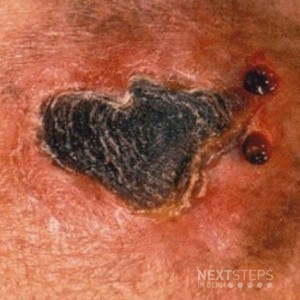
The correct answer is D. Clarithromycin.
This is a mycobacterial infection after surgery which is usually due to M. Chelonei. It presents with SQ nodules that ulcerate and drain. The treatment is to drain and treat with clarithromycin as first-line antibiotic therapy.
Treatment of atypical mycobacterial infections depends upon the infecting organism and the severity of the infection. In most cases a course of antibiotics is necessary. These include rifampicin, ethambutol, isoniazid, minocycline, ciprofloxacin, clarithromycin, azithromycin and cotrimoxazole. Usually treatment consists of a combination of drugs.
Consider the following points when treating atypical mycobacterial infections with antibiotics:
- Mycobacterium marinum species are often resistant to isoniazid, streptomycin, pyrazinamide, and para-aminosalicylic acid. Effective antimicrobials include tetracyclines, fluoroquinolones, macrolides (eg, clarithromycin), rifampicin and sulfonamides (cotrimoxasole). Treatment should be for at least 4–6 weeks, and sometimes up to two months.
- Mycobacterium kansasii should be treated with at least 3 drugs for 12–18 months. One of the drugs must be rifampicin, which is still the cornerstone of treatment for these infections.
- Mycobacterium chelonae and M fortuitum are best treated with clarithromycin or azithromycin in localised infections, particularly if used with surgical debridement. Disseminated infections require combination treatment, usually a macrolide and an aminoglycoside eg, combinations of amikacin, tobramycin, imipenem, clarithromycin.
- Treatment of Mycobacterium ulcerans is most successful if treatment is started in lesions less than 6 months old with a diameter less than 10 cm. Rifampicin and streptomycin are the current recommended antibiotics.
- Surgery is used as an adjunct to antibiotic treatment in patients with severe infection. Most lesions eventually spontaneously heal after 6–9 months but may leave behind extensive scarring and disfigurement.
- AIDS patients on HIV protease inhibitor drugs cannot be treated with rifampicin because rifampicin significantly increases the breakdown of these drugs. Rifabutin is a suitable alternative.
Surgical removal of infected lymph nodes and aggressive debridement of infected skin lesions is sometimes necessary. In severe cases, skin grafts may be necessary to repair the surgical wound.
Some infections will heal spontaneously, leaving a scar (which is often very unsightly).
